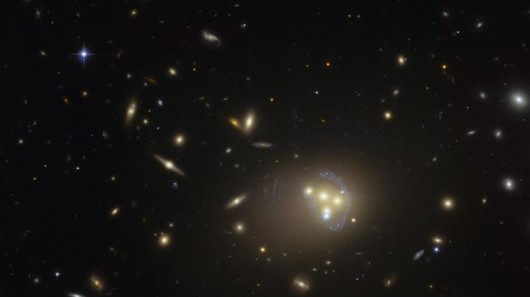
Galaxy cluster Abell 3827 (Image: ESO)
New studies by astronomers are slowly throwing some light on dark matter, the invisible and mysterious stuff that scientists believe makes up much of the universe. For the first time, astronomers believe they've observed the interactions of dark matter via a factor other than the force of gravity.
Dark matter's gravitational interactions with the parts of the universe that we can actually see are the only reason that we know it exists at all. Weirdly, it has seemed until now that dark matter has no other known interactions with anything in the universe, including itself. A recent study seemed to back up the notion that bits of dark matter appear to just drift through space, and not even interact with each other.
However, new observations of the simultaneous collision of four galaxies in the galaxy cluster Abell 3827 using the European Southern Observatory's Very Large Telescope (VLT) in Chile and a technique called "gravitational lensing" seemed to show a "clump" of dark matter around one of the galaxies, lagging a bit behind that galaxy.
This sort of lollygagging is something that scientists have predicted might be observable during collisions if dark matter were to interact with itself through some force other than gravity, even slightly.
"We used to think that dark matter just sits around, minding its own business, except for its gravitational pull," said Richard Massey at Durham University, lead author of a paper on the study. "But if dark matter were being slowed down during this collision, it could be the first evidence for rich physics in the dark sector the hidden Universe all around us."
Massey was also part of the study from last month which seemed to show that dark matter does interact even with itself at all. The researchers say the new findings do not necessarily conflict with the earlier study, however. That's because the new research looks at the motion of individual galaxies rather than galaxy clusters, along with the fact that collisions between them may have lasted longer, allowing a small frictional force to build up over a time span lasting between "only" 100 million years to about a billion years.
Massey believes that when looked at together, the two studies may actually work to put limits on the behavior of dark matter. "We are finally homing in dark matter from above and below squeezing our knowledge from two directions," he said. "Dark matter, were coming for you."
The research paper was recently published in the journal Monthly Notices of the Royal Astronomical Society. Source: ESO
copyright © Gizmag 2003 - 2015